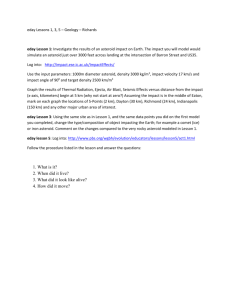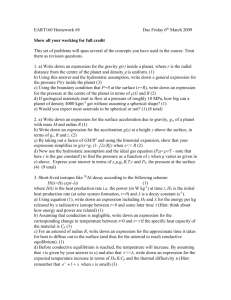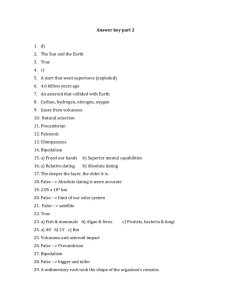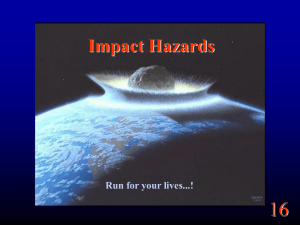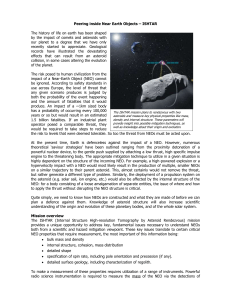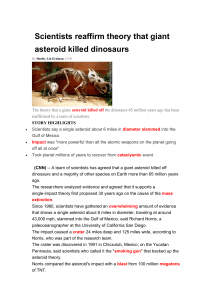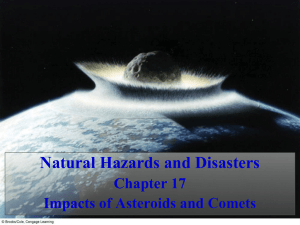MFF UK, AUUK, V Holešovičkách 2, 180 00 Praha 8
advertisement
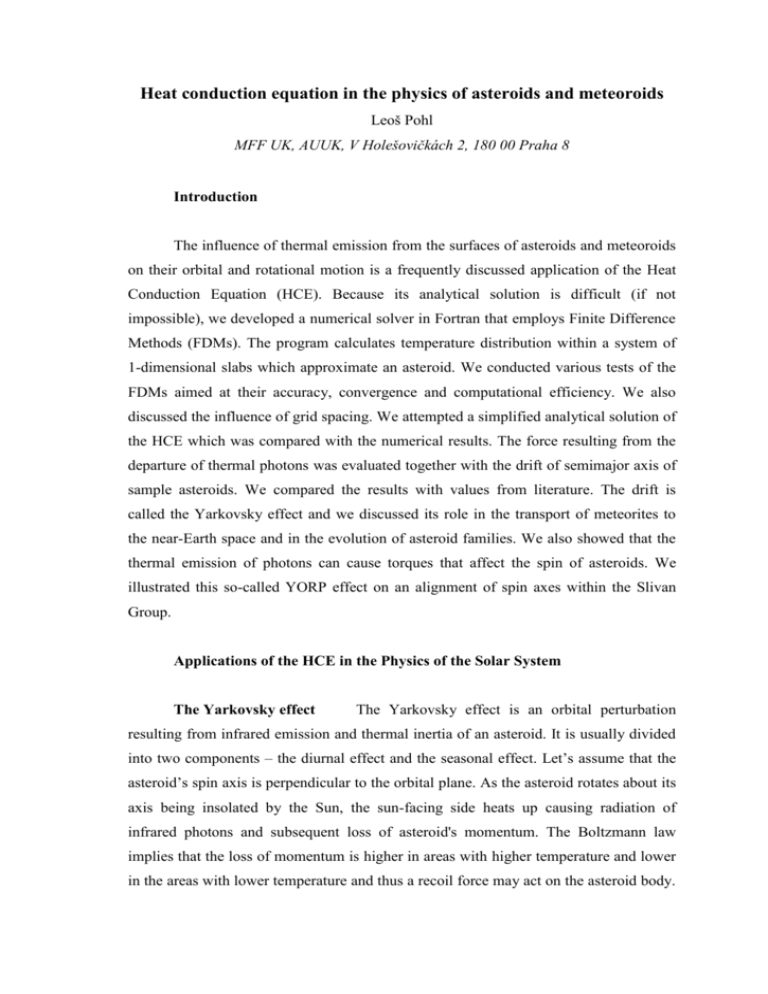
Heat conduction equation in the physics of asteroids and meteoroids Leoš Pohl MFF UK, AUUK, V Holešovičkách 2, 180 00 Praha 8 Introduction The influence of thermal emission from the surfaces of asteroids and meteoroids on their orbital and rotational motion is a frequently discussed application of the Heat Conduction Equation (HCE). Because its analytical solution is difficult (if not impossible), we developed a numerical solver in Fortran that employs Finite Difference Methods (FDMs). The program calculates temperature distribution within a system of 1-dimensional slabs which approximate an asteroid. We conducted various tests of the FDMs aimed at their accuracy, convergence and computational efficiency. We also discussed the influence of grid spacing. We attempted a simplified analytical solution of the HCE which was compared with the numerical results. The force resulting from the departure of thermal photons was evaluated together with the drift of semimajor axis of sample asteroids. We compared the results with values from literature. The drift is called the Yarkovsky effect and we discussed its role in the transport of meteorites to the near-Earth space and in the evolution of asteroid families. We also showed that the thermal emission of photons can cause torques that affect the spin of asteroids. We illustrated this so-called YORP effect on an alignment of spin axes within the Slivan Group. Applications of the HCE in the Physics of the Solar System The Yarkovsky effect The Yarkovsky effect is an orbital perturbation resulting from infrared emission and thermal inertia of an asteroid. It is usually divided into two components – the diurnal effect and the seasonal effect. Let’s assume that the asteroid’s spin axis is perpendicular to the orbital plane. As the asteroid rotates about its axis being insolated by the Sun, the sun-facing side heats up causing radiation of infrared photons and subsequent loss of asteroid's momentum. The Boltzmann law implies that the loss of momentum is higher in areas with higher temperature and lower in the areas with lower temperature and thus a recoil force may act on the asteroid body. The thermal inertia of the asteroid causes the temperature to take the maximum value later than the insolation function and so does the loss of momentum. This gives rise to acceleration along the orbital motion of the asteroid which can lead to substantial semimajor axis drift. The semimajor axis drift can be estimated from a simplified Gauss equation – , where is the asteroid’s mean motion and the transversal component of acceleration. The seasonal effect is related to the asteroid’s orbital motion and it always decays the orbit of the asteroid. The Yarkovsky effect depends on the size of the asteroid . The diurnal effect is the largest for centimeter to meter sized bodies, the seasonal effect for about 10 meter bodies. We discussed the Yarkovsky effect, and its role in the transport of meteorites to the Earth and in the evolution of asteroid families. The YORP effect Let's have an asteroid of a perfectly spherical shape. Let's attach a wedge to the asteroid's equator. The photons departing from the insolated wedge face carry away momentum in direction that lies in the equatorial plane which either spins the asteroid up or down. The momentum the photons carry away in the direction perpendicular to the plane changes the obliquity. The YORP effect is illustrated on a preferential alignment of spin axes within the Slivan Group. Mathematical and Physical Background We have an asteroid orbiting the Sun at an angular speed axis at and rotating about its . As the asteroid absorbs heat flux from the Sun, the temperature of its sun- facing side rises. If we were standing on the equator and measuring the temperature on the surface and the rotation axis was in the orbiting plane and perpendicular to the Sun direction vector (originating in the centre of the asteroid and aiming at the Sun), we would find out that the temperature would be the highest in the afternoon rather than at noon. This is due to a property of materials which can be called thermal inertia. Taking into account the Stefan-Boltzmann law, Boltzmann constant, - radiation area, ( - emissivity, - Stefan- the temperature on ) , the photon radiation is the highest in the afternoon too. However, the loss of photons implies additional nongravitational forces that act on the asteroid. To evaluate these forces, we need to know the temperature distribution on the surface and thus solve the HCE. We solve only one-dimensional HCE. Nonetheless, the 1-D simplification yields useful results. We can divide the asteroid into thin 1-D slabs originating in the centre and extending up to an surface point. In one dimension the HCE takes the form: where is the conductivity of the asteroid’s material in density in and , , is the bulk is the specific heat capacity of the material in , denote derivatives of temperature w.r.t. time and space variables and is an equilibrium temperature1 that is determined from the heat radiation incident on the object. The is the temperature on the surface and it is determined from energy conservation on the surface ( ): We use FDMs to numerically approximate solution of the HCE. This is achieved by transforming the above HCE into a finite difference equation. We use 3 FDMs. They differ according to what kind of difference is used to replace the time derivative: 1) we replace the time derivative with a forward difference (FTCS), 2) a backward difference (BTCS) and 3) a central difference (CTCS). In all cases the space derivate is replaced by the central difference. Unlike the FTCS method, the BTCS and CTCS methods require solving a set of linear equations, however, our boundary condition is a fourth-order polynomial and supplying the condition to the set of equations transforms it to a nonlinear one. To avoid this non-linear set, we have to approximate the subsurface temperature ( ) which appears in the boundary condition after the transformation to finite differences). We implemented 3 methods to approximate the subsurface temperature – the BTCS1 method replaces with (i.e. the subsurface temperature from the previous time step); the BTCS2 method starts also with the subsurface temperature from the previous time step, it then solves the set of equation leading to which is then used in the boundary condition and so forth until a required precision is achieved. The BTCS3 method calculates using a FTCS step. Although the FTCS method does not solve a set of equations which makes it a very efficient algorithm, however, it can be 1 The fact that we assume the temperature in the centre of the asteroid remains unchanged, i.e. the temperature variations on the surface do not propagate to the centre. shown (Press et al. 1987) that the FTCS method only converges for (so called von Neumann stability criterion) limiting the usable grids. Comparison of the methods and analytical solution We showed that the methods successfully converge as the grids become denser. In terms of accuracy we consider the BTCS2 method the most accurate. Despite several simplifications and an assumption of a harmonic insolation function, we can conclude that the derived analytical solution provides some good first-guess estimates. We also estimated force on 4 sample asteroids of the order . The transversal accelerations (along the direction of orbital motion) of the asteroids ranged between to contributes to . Based on the transversal acceleration which the semimajor for a bulk density drift ( ) most significantly, we estimated basalt asteroid (heat conductivity , specific heat capacity ) with period. For a regolith asteroid (conductivity ), we estimated , rotation , bulk density . These values are in order-of- magnitude agreement with values from literature. Acknowledgements I would like to express my sincere gratitude to my supervisor Mgr. Miroslavov Brož Ph.D. for his friendly approach, for the time he spent discussing the topics and evaluating my work and for valuable insights. References [Bertotti et al. 2003] Bertotti, B., Farinella, P., Vokrouhlický, D. 2003. Physics of the Solar System. Dordrecht: Kluwer Academic Publishers. ISBN 1402014287. [Bottke et al. 2001] Bottke, W.~F., Vokrouhlický, D., Brož, M., Nesvorný, D., & Morbidelli, A. 2001, Science, 294, 1693 [Bottke et al. 2006] Bottke, W. F., Vokrouhlický, D., Rubincam, D. P., Nesvorný, D. 2006. The Yarkovsky and Yorp Effects: Implications for Asteroid Dynamics. Annual Review of Earth and Planetary Sciences, 34, 157 [Brož, Vokrouhlický 2008] Brož, M., Vokrouhlický, D. 2008. Asteroid families in the first-order resonances with Jupiter. Monthly Notices of the Royal Astronomical Society 390, 715 [Brož, Šolc, Ďurech], Brož, M., Šolc, M., Ďurech, J., Fyzika malých těles sluneční soustavy, available on 18.05.2011 at http://sirrah.troja.mff.cuni.cz/~mira/fyzika\_malych\_teles/fmt\_20110504.pdf [Čapek 2007] Čapek, D. 2007. Thermal Effects in the Physics and Dynamics of the Small Solar System Bodies. Ph.D. Thesis, Charles Univ. [Chesley et al. 2003] Chesley, S.~R., et al.\ 2003, Science, 302, 1739 [Harmanec, Brož 2011] Harmanec, P., Brož, M., Stavba a vývoj hvězd, Praha, Matfyzpress, 2011, p. 36 [Langtangen 2003] Langtangen, H. P. 2003. Computational Partial Differential Equations, Numerical Methods and Diffpack Programming. Springer-Verlag. ISBN 3540-43416-X. [Pravec et al. 2002] Pravec, P., Harris, A.~W., Michalowski, T.\ 2002, in Asteroids III, W.~F.~Bottke, A.~Cellino, P.~Paolicchi, R.~P.~Binzel (eds), Tuscon: University of Arizona Press, p. 113 [Press et al. 1997] Press, W.H., Flannery, B.P., Teukolsky, S.A., Vetterling, W.T. 1997. Numerical Recipes in Fortran: The Art of Scientific Computing. Cambridge: Cambridge University Press. [Rubincam 1987] Rubincam, D.~P. 1987, Journal of Geophysical Research, 92, 1287 [Slivan 2002] Slivan, S.~M. 2002, Nature, 419, 49 [Lowry et al. 2007] Lowry, S.~C., et al., 2007, Science, 316, 272 [Vokrouhlický & Farinella 2000] Vokrouhlický, D., & Farinella, P. 2000, Nature, 407, 606 [Vokrouhlický et al. 2003] Vokrouhlický, D., Nesvorný, D., & Bottke, W.~F. 2003, Nature, 425, 147 [Vokrouhlický et al. 2006] Vokrouhlický, D., Brož, M., Morbidelli, A., Bottke, W.~F., Nesvorný, D., Lazzaro, D., & Rivkin, A.~S. 2006, Icarus, 182, 92

